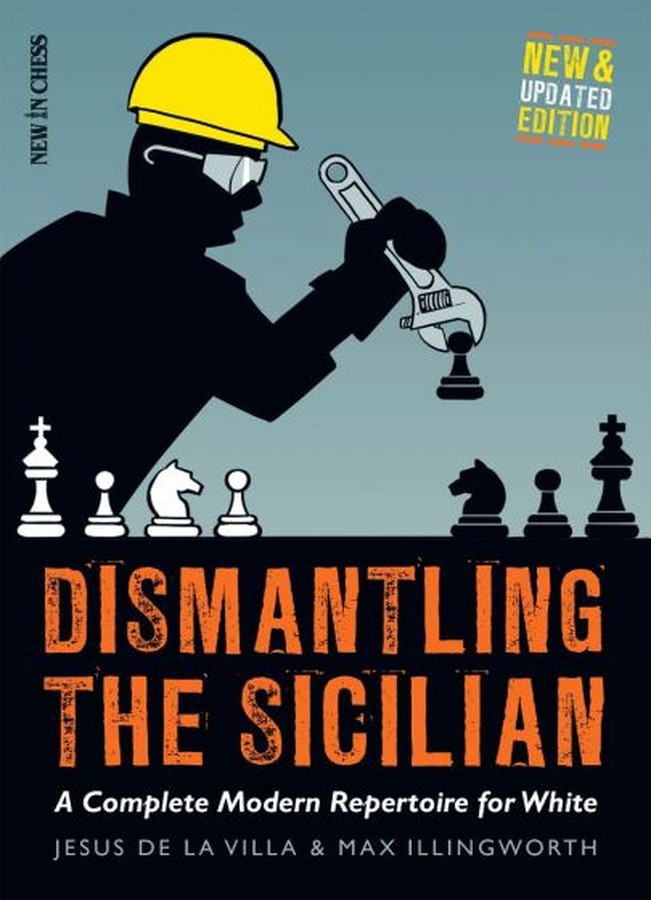| Nivå | B-D |
| Utgivelsesdato | November 2017 |
| Forfatter | |
| Pris | 305 NOK |
Dismantling the Sicilian, New and Updated
A Complete Modern Repertoire for WhiteDen australske stormestere Max Illingworth har særdeles oppdatert, utvidet og i stor grad nyskrevet stormester de la Villas suksessbok fra 2009 med et komplett repertoar for hvit i åpen siciliansk, 1 e4 c5 2 Sf3 med planen 3 d4.
I ett bind kombinerer den ganske elegant og realistisk behovene til både mesterspillere med begrenset tid til å sette seg inn i "alle detaljer" og mindre sterke og kyndige spillere som ønsker å lære ideer og praktiske oppskrifter mot de ulike forgreiningene som svart kan forsøke.
Fortsatt gjelder det nok at hvits beste objektive sjanser til å presse, utfordre og angripe svart i siciliansk går gjennom å spille åpent med Sf3 og d4.
Vår norske stormester Torbjørn Ringdal Hansen er imponerende representert med to gevinstpartier i boka.
Forlagets egen omtale
This a completely new edition, updated and extended from the original 2009 publication. It includes important changes in the basic framework of the repertoire and presents lots of new ideas and hundreds of novelties.
The Sicilian Defence is the most widely played chess opening, both at club level as well as among top grandmasters. Since Black gets dynamic play in almost all variations, Black players of all levels will probably continue to play the Sicilian for a long time to come.
It has been difficult for White to obtain any advantage in Sicilian sidelines, and this book therefore presents a complete repertoire for White in the most important main lines: the Open Sicilians with 1.e4 c5 2.Nf3. Each variation is presented with its main ideas, its typical tactics and strategies, and with instructive games. The authors always summarize the most important features.
PRAISE FOR THE ORIGINAL 2009 EDITION:
A total knockout.
Arne Moll, ChessVibes“Bang up-to-date and very user-friendly.”
John Anderson, British Correspondence Chess Association“Impressive and highly recommended.”
Grandmaster Glenn Flear
Fra det nye forordet
As I show in the uniquely New In Chess chapter called ‘What others recommend... and why I disagree’ (no. 17), overviewing the recommendations of the previous edition as well as Negi’s series, the English Attack has been neutralised by modern computers. Particularly the modern main line of the Najdorf/Scheveningen English Attack has been virtually analysed to a draw by deep engine analysis. You will still have plenty of opportunities to charge Garry the g-pawn in this repertoire – with the difference that mostly we will be supporting this aggression with h2-h3, ♗e2 or f2-f4.
Furthermore, it has recently become popular in the Open Sicilian to castle queenside with our queen more aggressively placed on e2 or f3, as you can study in the Taimanov, Scheveningen and Najdorf chapters. The theory is still developing in these systems, but I’ve made a strong case that White is fighting for an opening advantage, which can easily increase if Black settles for natural developing moves (as is frequently the case at the amateur level).
I’ve noticed on online chess forums and blogs that readers desire clear explanations of ideas, and lament getting bogged down in swathes of 9 Introduction to the new edition variations, most of which they are unlikely to face over the board. This book doesn’t skimp on detail either, but I have divided each chapter into a ‘theoretical overview’ section and an ‘illustrative games’ section, so you may play the repertoire successfully without needing to read cover-to- cover.
Inexperienced players can play through the games in the ‘illustrative games’ section and quickly apply the typical middlegame plans, themes and tactics. Advanced players can find all the theory they need to know (and a bit more!) explained in the theoretical overviews. Finally, professional players can subsequently work through the illustrative games for further detail, as well as reserve options to complicate the opponent’s preparation. There are some inevitable wide branches for Black’s most flexible systems, so you may choose to skip the sidelines in each branch on a first read for a ‘quick repertoire’.
In principle, I have offered alternatives only where I was unable to clearly prove a white advantage, but there are some exceptions where I included another good option for its similarity with another repertoire line, or to improve our understanding of the Open Sicilian.
| Innbundet? | Nei |
| Type | Bok |
| Språk | Engelsk |
| Antall sider | 367 |

